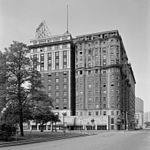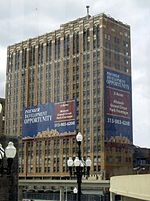Cliff Bell's
1935 establishments in MichiganBuildings and structures in DetroitCulture of DetroitDetroit building and structure stubsEvent venues established in 1935 ... and 2 more
Jazz club stubsMusic venues in Michigan

Cliff Bell's is a jazz club in Detroit, Michigan which is located at 2030 Park Ave. It originally opened in 1935, and it is named after John Clifford Bell, an entrepreneur in Detroit in the 1930s. Notable artists such as Marcus Miller have performed at Cliff Bell's. Additionally, The Moth storytelling events are held monthly at Cliff Bell's.It was used as a location in the movie The Ides of March, in a scene where Detroit musician Bob Mervak was briefly shown singing We'll Meet Again. The entrance was also seen in the film Kill the Irishman, filming up Park Avenue.
Excerpt from the Wikipedia article Cliff Bell's (License: CC BY-SA 3.0, Authors, Images).Cliff Bell's
Park Avenue, Detroit
Geographical coordinates (GPS) Address Nearby Places Show on map
Geographical coordinates (GPS)
| Latitude | Longitude |
|---|---|
| N 42.3368 ° | E -83.0527 ° |
Address
Campau Realty Building
Park Avenue 2030
48226 Detroit
Michigan, United States
Open on Google Maps









